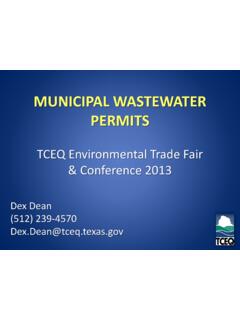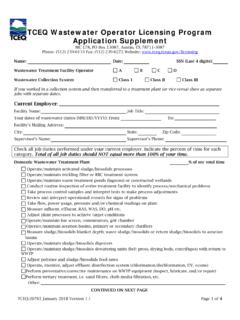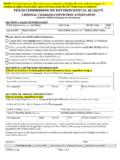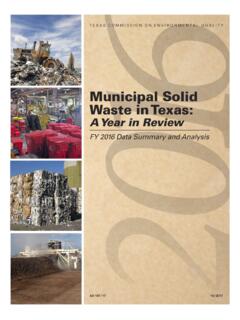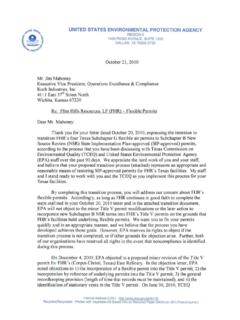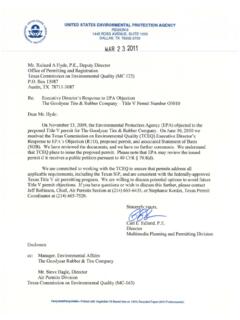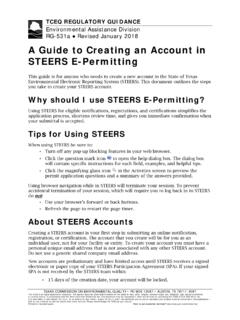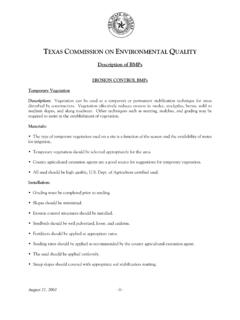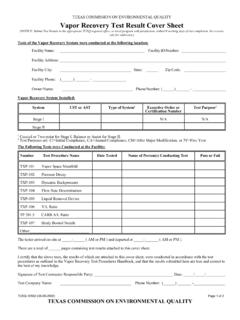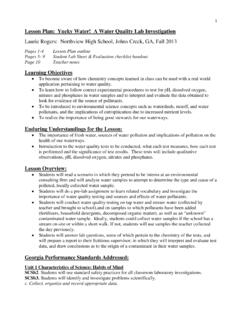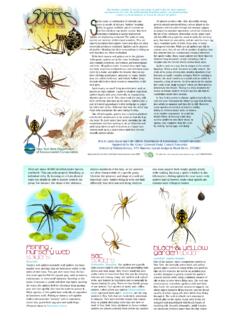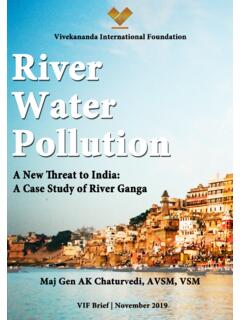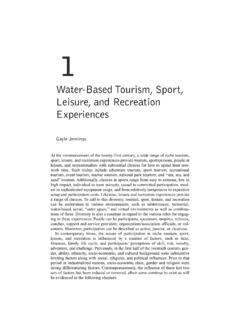Transcription of Jar Testing: How to Design and Perform Representative Jar ...
1 TEXAS OPTIMIZATION PROGRAM (TOP) DIRECTED ASSISTANCE MODULE (DAM) 2B JAR TESTING: HOW TO Design AND Perform Representative JAR TESTS FOR A SURFACE water TREATMENT PLANT (SWTP) STUDENT GUIDE Most recent revision date: September 8, 2019 Notes i Table of Contents Figures .. v Tables .. v Definition of Terms, Acronyms, and Symbols .. vii Bottom Line: (Revise to be Intro, learning goals) .. Error! Bookmark not defined. Purpose of surface water treatment, role of coagulation .. 2 SWTP barriers .. 2 Removal and inactivation .. 2 Turbidity monitoring .. 4 What makes coagulation necessary? .. 5 Factors Influencing Coagulation: .. 10 Velocity Gradient .. 11 Definition of Velocity Gradient: ..11 Calculation of Mean Velocity Gradient G Using Power Input: ..11 Calculation of Mean Velocity Gradient G Using Head Loss: ..11 Calculation of Mean Velocity Gradient G for Air Diffusers.
2 12 Time Considerations: ..13 Temperature and Viscosity: ..14 Types of Mixers: ..15 Hydraulic Mixers .. 16 Mechanical Mixers .. 21 Sedimentation Basins .. 26 Definition of Surface Overflow Rate: ..26 Relation of SOR to Settling Rate: ..28 Definition of Hydraulic Detention Time (HDT): ..29 Bottom Line: .. 29 Square versus Round Jars: .. 30 Table of Conversion Factors: .. 32 Attachment 1 to the Student Guide .. 36 Chemical Feed Rate and Dosage Calculations Form .. 36 Directed Assistance Module 2-B .. 36 Establishing Appropriate Chemical Feed Rates .. 36 Using Representative Jar Testing .. 36 Chemical Feed Rate Measurement and Dosage Calculations .. 1 Chemical Feed Rate Measurements and Dosage Calculations .. 1 ii Chemical Feed Rate Measurement and Dosage Calculations (continued) .. 3 II. Chemical Feeder Calibration Data (1, 2) .. 3 Attachment 2 to the Student Guide.
3 4 Chemical Dosage Calculation .. 4 Directed Assistance Module 2-B .. 4 Establishing Appropriate Chemical Feed Rates .. 4 Using Representative Jar Testing .. 4 Chemical Dosage Calculations .. 1 Chemical Dosage Calculations (continued) .. 2 Summary of Methods for Calculating the Dose of Liquid Chemicals .. 2 Chemical Dosage Calculations (continued) .. 4 Volume Based Dosage Calculations for Liquid Aluminum Sulfate (Alum) .. 6 (and other liquid chemicals) .. 6 Feed Rate to Dosage Calculation for Volume Based Doses .. 6 Dosage to Feed Rate Calculation for Volume Based Doses .. 6 Stock Solution Calculations for Volume Based Doses .. 7 Liquid Weight Based Dosage Calculations for Liquid Aluminum Sulfate (Alum).. 9 (and other liquid chemicals) .. 9 Feed Rate to Dosage Calculation for Liquid Weight Doses .. 9 Feed Rate to Dosage Calculation for Liquid Weight Doses (Continued).
4 Error! Bookmark not defined. Dosage to Feed Rate Calculation for Liquid Weight Doses .. 10 Stock Solution Calculation for Liquid Weight Based Doses .. 11 Dry Weight Based Dosage Calculations for Liquid Aluminum Sulfate (Alum) and Other Liquid Chemicals .. 13 Feed Rate to Dosage Calculation for Dry Weight Based Doses of Liquid Alum .. 13 Feed Rate to Dosage Calculation for Dry Weight Based Doses of Liquid Alum (continued) .. Error! Bookmark not defined. Dosage to Feed Rate Calculations for Dry Weight Based Doses of Liquid Alum or Other Chemicals Mixed with water .. 15 Stock Solution Calculations for Dry Weight Based Doses of Liquid Alum .. 16 or Other Chemicals Mixed with water .. 16 Dosage Calculations for Gaseous Chemicals and Dry 17 iii Feed Rate to Dosage Calculations for Gas Chemicals .. 17 Feed Rate to Dosage Calculations for Solid Dry Chemicals .. 17 Dosage to Feed Rate Calculations for Gas Chemicals.
5 18 Dosage to Feed Rate Calculations for Solid Dry Chemicals .. 19 Stock Solution Calculations for Dry Weight Based Doses of Liquid Alum .. 19 or Other Chemicals Mixed with water ).. 19 Attachment 3 to the Student Guide .. 20 Preparing Stock Solutions .. 20 Directed Assistance Module 2-B .. 20 Establishing Appropriate Chemical Feed Rates .. 20 Using Representative Jar Testing .. 20 Definitions .. 1 Preparing Stock Solutions .. 2 Preparing Stock Solutions (continued) .. 3 Attachment 4 to the Student Guide .. 2 Jar Testing Form .. 2 Directed Assistance Module 2-B .. 2 Establishing Appropriate Chemical Feed Rates .. 2 Using Representative Jar Testing .. 2 Jar Testing Form .. 1 More Than One Type of Jar Test .. 2 Jar Testing (continued) .. 4 Conventional Jar Tests .. 4 Initial rapid mix conditions .. 4 Dynamic Jar Tests .. 5 Attachment 5 to the Student Guide .. 7 Jar Test Comparison Form.
6 7 Directed Assistance Module 2-B .. 7 Establishing Appropriate Chemical Feed Rates .. 7 Using Representative Jar Testing .. 7 JAR TEST COMPARISON FORM .. 1 Conventions in this Module .. 5 iv Multiplied by: .. 5 Divided by: .. 5 Concentration (Conc.): .. 5 Residual (Res.) .. 5 Flow Rates versus Feed Rates: .. 6 Milligrams per Liter (mg/L) and parts per million (ppm): .. 6 Use of Exponents: .. 6 Order of Execution in Equations: .. 6 Attachment 6 to the Student Guide .. 7 Calculating Chemical Feed Rates .. 7 Directed Assistance Module 2-B .. 7 Establishing Appropriate Chemical Feed Rates .. 7 Using Representative Jar Testing .. 7 Calculating Chemical Feed Rates .. 1 Calculating Chemical Feed Rates (continued) .. 2 v Figures Figure 1: Multi-barrier Approach to Producing Safe Drinking water .. 3 Figure 2: Good Coagulation is Key to Effective Sedimentation .. 4 Figure 3: Size Ranges for Particles Found in Untreated Surface water .
7 6 Figure 4: Natural State of Small Particles in water .. 7 Figure 5: Reactions Between Particles and Polymers .. 9 Figure 6: Types of Mixing Devices .. 15 Figure 7: Head Losses in Pipe Flow Hydraulic Mixing .. 17 Figure 8: Head Loss in a Baffled Basin .. 18 Figure 9: Venturi Section Mixer .. 18 Figure 10: Hydraulic Jump Mixer .. 19 Figure 11: Weir Mixer .. 20 Figure 12: In-line Static Mixer .. 20 Figure 14: Mechanical Mixers .. 22 Figure 15: In-line Mechanical Mixer .. 23 Figure 16: Horizontal Paddle Flocculator .. 24 Figure 17: Comparison of Turbulence in Round and Square Jars .. 30 Figure 18: Square 2-Liter Jars .. 32 Tables Table 1: Definition of Terms, Acronyms, and Symbols .. vii Table 2: Relative Sizes and Characteristics of Particles (with a Specific Gravity of ) in water .. 6 Table 3: Typical Detention Times, Velocity Gradients and Gt Factors for Rapid Mix Units.
8 13 Table 4: water Temperature and Viscosity .. 14 Table 5: Detention Time Factors .. 14 Table 6: Impeller Power Number (Np) .. 22 Table 7: Typical Velocity Gradients in Tapered Mixing .. 24 Table 8: General Design Criteria for Flocculation Basins (a) .. 25 Table 9: Configuration for Common Sedimentation 27 Table 10: EPA Criteria for Process Evaluation: Sedimentation .. 28 vi Table 11: Settling Velocity of Selected Flocs .. 28 Table 12: Recommended Sedimentation/Clarification .. 29 Table 13: Conversion Factors .. 33 vii Definition of Terms, Acronyms, and Symbols Term, Acronym, Symbol Definition A Area (square feet) Anionic Negatively charged B Bend head losses in a pipe bbl Barrels Cationic Positively charged Crypto Cryptosporidium EPA Environmental Protection Agency F Friction head losses in a pipe ft foot (feet) ft2 Square foot (Square feet) ft3 Cubic foot (Cubic feet) G Velocity gradient (sec-1) g Acceleration due to gravity ( ft/sec2) gpg Grains-per-gallon gpm Gallons per minute gr Grains Gt Gt Factor: Velocity gradient times the time of contact h Head (feet of water ) HDT Hydraulic detention time HL Head loss (feet of water ) hrs Hours in Inches in2 Square inch(es) Kg Kilograms L Liters lb (lbs.)
9 Pound (Pounds) m Meter(s) viii Term, Acronym, Symbol Definition m2 Square meter(s) m3 Cubic meter(s) mg Milligram(s) MG Millions of gallons mg/L Milligrams per liter MGD Millions of gallons per day min Minute(s) ml Milliliters mm Millimeter(s) Nonionic With no ionic charge NP Propeller number NTU Nephalometric Turbidity Unit oC Degrees Centigrade oF Degrees Fahrenheit pH A measure of the acidity or basicity of a compound ppm Parts-per-million Q Flow rate (gpm, MGD, etc.) Sec Seconds SOR Surface overflow rate Stds. Standards T (t) Time TSC Technical Support Center V Volume (cubic feet, gallons, MG, etc.) Wt Weight of one cubic foot of water ( pounds) Yrs Years Viscosity [pound-seconds/square foot] DAM 2B: Jar Testing Student Guide Page 1 Learning goals In this DAM, we expect you to learn: How to mix stock solutions for jar testing, How to Perform a jar test, Pros and cons of different jar testing methods A successful jar testing procedure must successfully incorporate all the mixing factors for flash mixing and flocculation and settling in order to be an effective predictor of the performance of the plant.
10 Historically, operators attend a surface water class or a laboratory class where a jar test is demonstrated and they come away with the idea that the way they were shown is exactly how it is always done. This is not, in fact, the way this training should be interpreted. Classroom demonstrations are fine, excepting that they are rarely adapted to a plant where water is being treated. In other words, they are not Representative of what is going on in your particular plant. In the following pages, we discuss 16 different mixing devices, and this does not include all the mixing units commonly found in Texas. We also discuss elements of floc formation and settling. Representative jar testing means that the jar test procedure will imitate the coagulation, flocculation, and settling conducted in the water plant. There is no single jar test procedure will duplicate all of these processes for all plants, however, experience shows that jar test procedures can be individually tailored to accurately predict performance for almost every plant.
